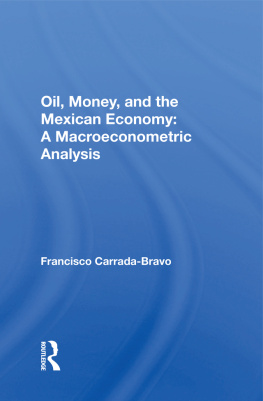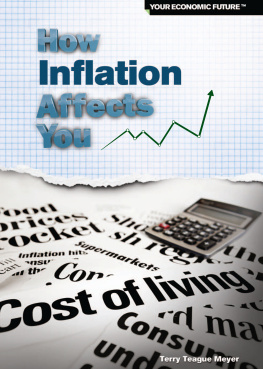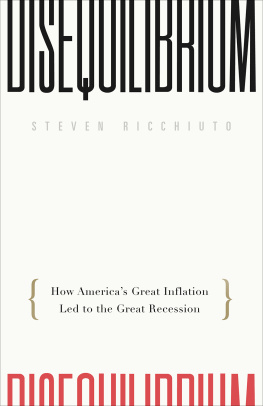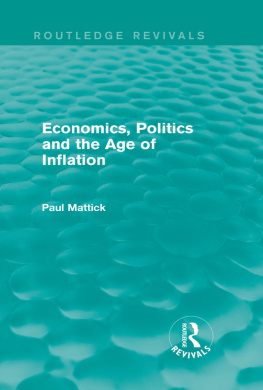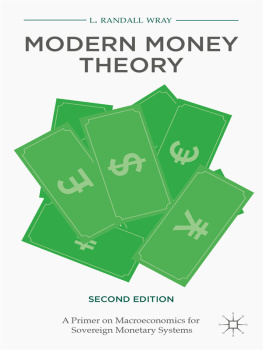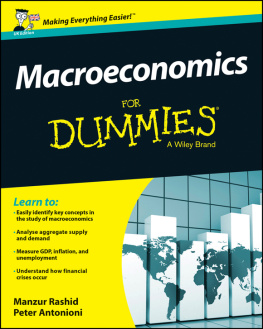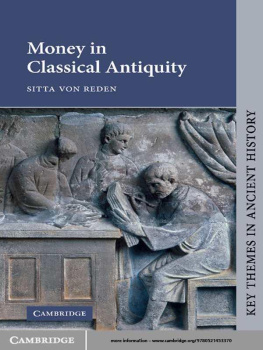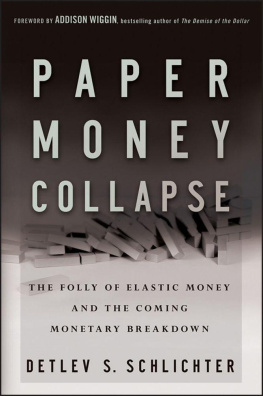Oil, Money, and the Mexican Economy
About the Book and Author
Oil, Money, and the Mexican Economy: A Macroeconometric Analysis
FranciscoCarrada-Bravo
In the mid-1970s, unemployment, inflation, and monetary disturbances were dominant forces in the Mexican economy. Beginning in late 1977, however, the situation drastically changed. The discovery of enormous oil fields, combined with structural and social factors, vastly improved the nation's prospects, and in terms of business cycles, its economy moved from trough to peak.
In assessing these changes, Dr. Carrada constructs a macroeconometric macroeconoraetric modelbased on the monetary approach to the balance of paymentsto deal in the short-run with structural features of Mexico's economy. He then applies his model to a variety of scenarios in order to explore the short-run dynamic impact of oil revenues on real incomes, private and government expenditures, private and public investment, prices, inflation, money supply, and balance of payments. Incorporating theoretical and empirical evidence of how expectations affect levels of economic activity and inflation, Dr. Carrada's model is applicable also to the conditions of other oil-rich developing countries.
Dr. Carrada is director of economic studies and associate professor of economics at the Monterrey Institute of Technology in Mexico.
Oil, Money, and the Mexican Economy: A Macroeconometric Analysis
Francisco Carrada-Bravo

First published 1982 by Westview Press, Inc.
Published 2021 by Routledge
605 Third Avenue, New York, NY 10017
2 Park Square, Milton Park, Abingdon, Oxon OX14 4RN
Routledge is an imprint of the Taylor & Francis Group, an informa business
Copyright 1982 by Taylor & Francis
All rights reserved. No part of this book may be reprinted or reproduced or utilised in any form or by any electronic, mechanical, or other means, now known or hereafter invented, including photocopying and recording, or in any information storage or retrieval system, without permission in writing from the publishers.
Notice:
Product or corporate names may be trademarks or registered trademarks, and are used only for identification and explanation without intent to infringe.
Library of Congress Catalog Card Number: 82-50687
ISBN 13: 978-0-3670-1723-1 (hbk)
ISBN 13: 978-0-3671-6710-3 (pbk)
DOI: 10.4324/9780429047091
TO MY PARENTS
TEODORO
AND
MARIA DEL CARMEN CARRADA
Contents
- 2 THE DESCRIPTION OF THE MODEL
- The Oil Sector
- The Transmission Mechanism
- The Structure of the Non-Oil System
- Real Demand for Imports
- Real Aggregate Expenditure
- The Demand for Real Cash Balances
- Private Consumption
- Real Government Expenditures
- Real Private Investment
- Real Government Investment
- The Money Supply
- The Monetary Balance of Payments
- The Inflation Rate
- The Dynamic Adjustment of the Output
- The Dynamic Adjustment of the International Capital Flows
- 3 EMPIRICAL EVIDENCE FOR MEXICO
- Aggregate Absorption
- Real Private Consumption
- Real Government Expenditures
- Real Private Investment
- Government Investment
- Real Imports
- Income and Excess Capacity
- Prices and Inflation
- The Monetary Sector
- The Balance of Payments
- The Simulation of the Model
- The Simulation Scenarios
- "The Lack of Government Spending": Scenario Set
- "The Dynamics of the Stationary State": Scenario (4)
- "The Varying Oil Revenues Over Time": Scenario (5)
- "The Historical Trend": Scenario (6)
- "The Unconstrained Model": Scenario Set
- "Varying Oil Revenues": Scenario (1)
- "Varying Oil Revenues Under Mild Inflationary Expectations": Scenario (2)
- "Varying Oil Revenues Under Inflationary Expectations": Scenario (3)
- "The Oil Revenues, Inflationary Expectations, and Domestic Monetary Policy": Scenario Set
- "Varying Oil Revenues Given Mild Inflationary Expectations and a Conservative Domestic Monetary Policy": Scenario (7)
- "Varying Oil Revenues Given Mild Inflationary Expectations and an Aggressive Monetary Policy": Scenario (8)
- "The Varying Oil Revenues Given Inflationary Expectations and Mild Domestic Monetary Policy": Scenario (9)
- Conclusions
- 4 SUMMARY REPORT, GENERAL CONCLUSIONS, AND RECOMMENDATIONS
- Summary Report
- General Conclusions
- Summary of Results
- 2 THE DESCRIPTION OF THE MODEL
- The Oil Sector
- The Transmission Mechanism
- The Structure of the Non-Oil System
- Real Demand for Imports
- Real Aggregate Expenditure
- The Demand for Real Cash Balances
- Private Consumption
- Real Government Expenditures
- Real Private Investment
- Real Government Investment
- The Money Supply
- The Monetary Balance of Payments
- The Inflation Rate
- The Dynamic Adjustment of the Output
- The Dynamic Adjustment of the International Capital Flows
- 3 EMPIRICAL EVIDENCE FOR MEXICO
- Aggregate Absorption
- Real Private Consumption
- Real Government Expenditures
- Real Private Investment
- Government Investment
- Real Imports
- Income and Excess Capacity
- Prices and Inflation
- The Monetary Sector
- The Balance of Payments
- The Simulation of the Model
- The Simulation Scenarios
- "The Lack of Government Spending": Scenario Set
- "The Dynamics of the Stationary State": Scenario (4)
- "The Varying Oil Revenues Over Time": Scenario (5)
- "The Historical Trend": Scenario (6)
- "The Unconstrained Model": Scenario Set
- "Varying Oil Revenues": Scenario (1)
- "Varying Oil Revenues Under Mild Inflationary Expectations": Scenario (2)
- "Varying Oil Revenues Under Inflationary Expectations": Scenario (3)
- "The Oil Revenues, Inflationary Expectations, and Domestic Monetary Policy": Scenario Set
- "Varying Oil Revenues Given Mild Inflationary Expectations and a Conservative Domestic Monetary Policy": Scenario (7)
- "Varying Oil Revenues Given Mild Inflationary Expectations and an Aggressive Monetary Policy": Scenario (8)
- "The Varying Oil Revenues Given Inflationary Expectations and Mild Domestic Monetary Policy": Scenario (9)
- Conclusions
- 4 SUMMARY REPORT, GENERAL CONCLUSIONS, AND RECOMMENDATIONS
- Summary Report
- General Conclusions
- Summary of Results
Guide
Tables and Figures
- Tables
- Figures
- 2.1 The Structure of the Mexican System
- 3.1 Scenario Assumptions
Acknowledgements
This study, of which my doctoral dissertation is an earlier version, was possible thanks to the help of many individuals and institutions. Among the persons who deserve special mention are Professor Barry W. Poulson, chairman of my dissertation committee, who reviewed at length the manuscript and suggested changes that improved both the content and the style of the study; Professor Malcom Dowling from whose vast econometric and macroeconomic knowledge in developed and developing countries this work has greatly benefited; Professor Jacob K. Atta who gave me very valuable advice in critical periods of the research work. To all of them my gratitude.

